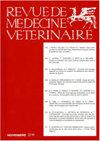Prevalencia de parásitos intestinales en perros de dos centros de bienestar animal de Medellín y el oriente antioqueño (Colombia), 2014
Q2 Veterinary
引用次数: 10
Abstract
In Colombia, there are very few studies about intestinal parasitosis in dogs, and street dogs constitute a high-risk group for the acquisition of parasitic zoonotic diseases. Through a cross-sectional descriptive study carried out in 2014, the prevalence of intestinal parasitosis and its associated factors were determined in 68 dogs of both sexes from two animal welfare centers in Medellin and eastern Antioquia (Colombia). The parasitological diagnosis was made by direct examination with saline solution at 0.8% and iodine, and the Sheather flotation method. The overall prevalence of intestinal parasitosis was 72.1% (49), helminths 58.8% (40), protozoa 33.8% (23) and parasitism in 45.6% (31). 11 parasitic agents, of which the most prevalent were Uncinaria stenocephala with 39.7% (27), were identified; Ancylostoma caninum, with 20.6% (14); Trichuris vulpis, with 16.2% (11) and Toxocara spp., with 11.8% (8). These were statistically higher in eastern Antioquia (p value chi2 0.05). A high prevalence of intestinal parasitism in dogs from Medellin and eastern Antioquia was evidenced, as well as a great diversity in the prevalence of the subgroups studied. This information highlights the need to promote research in order to determine the magnitude and associated factors in specific populations as the foundation for targeting actions on veterinary health and public health, given the zoonotic potential of some parasitosis of dogs.medellin和oriente antioquino(哥伦比亚)两个动物福利中心犬肠道寄生虫流行情况,2014年
在哥伦比亚,关于狗的肠道寄生虫病的研究很少,而街头狗是感染寄生虫人畜共患疾病的高危群体。通过2014年开展的横断面描述性研究,对来自麦德林和安蒂奥基亚东部(哥伦比亚)两个动物福利中心的68只雌雄犬的肠道寄生虫病患病率及其相关因素进行了测定。用0.8%的生理盐水加碘直接检查,采用套套浮选法进行寄生虫学诊断。总体肠道寄生虫病患病率为72.1%(49例),寄生虫患病率为58.8%(40例),原虫患病率为33.8%(23例),寄生虫患病率为45.6%(31例)。共鉴定寄生虫11种,其中以窄头棘虫(Uncinaria stenocephala)居多,占39.7%(27只);犬钩虫,占20.6% (14);在安蒂奥基亚东部地区,毛毛虫占16.2%(11只),弓形虫占11.8%(8只),差异有统计学意义(p值0.05)。在麦德林和安蒂奥基亚东部的狗中,肠道寄生虫病的患病率很高,而且所研究的亚群患病率存在很大差异。这一信息突出表明,鉴于某些犬类寄生虫病具有人畜共患的可能性,有必要促进研究,以确定特定人群中的严重程度和相关因素,作为兽医卫生和公共卫生方面有针对性行动的基础。
本文章由计算机程序翻译,如有差异,请以英文原文为准。
求助全文
约1分钟内获得全文
求助全文
来源期刊

Revue De Medecine Veterinaire
农林科学-兽医学
CiteScore
1.30
自引率
0.00%
发文量
0
审稿时长
18-36 weeks
期刊介绍:
The Revue de Médecine Vétérinaire publishes four kinds of text:
1) Scientific reviews on subjects related to veterinary and comparative medicine. Suggested length: 10 to 30 typed pages.
2) Original reports on fundamental or applied research. Suggested length: 10 to 15 typed pages.
3) Continuous education articles, that should be easily understandable by non-specialists. Suggested length: 10 to 15 typed pages.
4) Clinical reports. Suggested length: 5 to 15 typed pages.
The publication can be done in French language or English language.
For an article written in English by not english native speakers authors, the manuscript must be subjected by attesting that it was read again by an anglophone scientist or a scientific translator.
The authors must certify that the manuscript was not published or subjected for publication to another review.
The manuscript must be accompanied by a sheet signed by all the joint authors indicating their agreement for the tender of the manuscript.
The publication is free but a financial participation could be required for the photographs color. An estimate will be sent to collect the agreement of the authors.
 求助内容:
求助内容: 应助结果提醒方式:
应助结果提醒方式:


